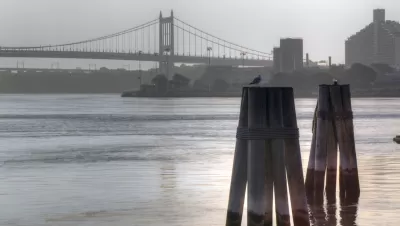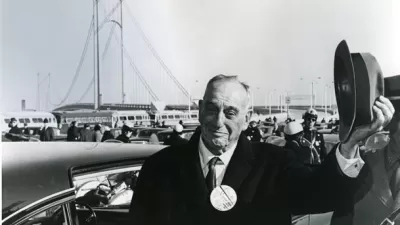A visit from the Dutch Prime Minister Mark Rutte to see Robert Caro, author of "The Power Broker," provides a refresher on the works of Robert Moses and Caro's writing.

Dutch Prime Minister Rutte and a friend were greatly influenced by Caro's epic biography, The Power Broker: Robert Moses and the Fall of New York. The two met up with Caro who had agreed to "show them some sights from the book," writes John Leland of The New York Times. Leland joined them in a narrated auto trip by the master historian to visit a handful of Moses' many creations.
Mr. Caro...pointed out Moses handiwork, which was basically everything in sight: the Robert F. Kennedy Bridge (formerly the Triborough Bridge), the northern extension of the F.D.R. Drive, the massive public housing projects in Queens and Upper Manhattan.
“Every building you see here was built by Robert Moses,” Mr. Caro said, gesturing toward the projects. “And there’s not a single architectural element to make them look better. Moses wanted the people living in them to feel poor.”
First stop was Randall Island, where Moses' main office for the Triborough Bridge Authority was located, directly below from where the three spans of the bridge (from three boroughs) meet. The bridge opened in 1936.
The Triborough Bridge Authority is now part of the Metropolitan Transportation Authority, which Gov. Nelson A. Rockefeller created to force Moses from power, Mr. Caro said. “It was the only way to get him out. Moses didn’t think it could be done.”
"MTA Bridges and Tunnels, legally known as the Triborough Bridge and Tunnel Authority, is an affiliate agency of the Metropolitan Transportation Authority, that operates seven intrastate toll bridges and two tunnels in New York City," according to Wikipedia.
Next up: "The Cross-Bronx Expressway, whose construction devastated a mile-long swath of the Bronx, uprooting a stable low-income neighborhood and leaving urban misery in its place," writes Leland.
When Mr. Caro was working on that part of the book, he said, it made him depressed and angry. He’d track down people who had been displaced, and the word they used to describe their lives afterward was “lonely.”
The Sheridan Expressway, also built by Moses, abuts the Cross-Bronx. It is budgeted to be razed and replaced with a ped/bike-friendly urban boulevard, as noted recently in a post that shows how far we have come from the destructive transportation policies embraced by Moses.
"Much has changed since “The Power Broker” came out in 1974, when it earned its subtitle about “The Fall of New York," writes Leland. "Mr. Caro said the subtitle reflected the city as Moses left it: crime rising, schools decaying, the city’s finances crumbling."
For Mr. Rutte, a lesson of the intervening years was that “leadership does matter,” he said, adding: “I used to walk in the Bowery in the early 1980s and it was not safe. It went from this to Disneyland under Giuliani and Bloomberg. This is now one of the best-run big cities in the world.”
Times have indeed changed in New York City since Moses' reign. Instead of building roadways that destroy neighborhoods, Mayor Michael Bloomberg and Transportation Commissioner Janette Sadik-Khan pedestrianized parts of Broadway with new plazas. Mayor Bill de Blasio continues in that vein with Transportation Commissioner Polly Trottenberg by taming notorious Queens Boulevard.
FULL STORY: The Dutch Prime Minister Is a Big Fan of Robert Caro

Alabama: Trump Terminates Settlements for Black Communities Harmed By Raw Sewage
Trump deemed the landmark civil rights agreement “illegal DEI and environmental justice policy.”

Planetizen Federal Action Tracker
A weekly monitor of how Trump’s orders and actions are impacting planners and planning in America.

Why Should We Subsidize Public Transportation?
Many public transit agencies face financial stress due to rising costs, declining fare revenue, and declining subsidies. Transit advocates must provide a strong business case for increasing public transit funding.

Understanding Road Diets
An explainer from Momentum highlights the advantages of reducing vehicle lanes in favor of more bike, transit, and pedestrian infrastructure.

New California Law Regulates Warehouse Pollution
A new law tightens building and emissions regulations for large distribution warehouses to mitigate air pollution and traffic in surrounding communities.

Phoenix Announces Opening Date for Light Rail Extension
The South Central extension will connect South Phoenix to downtown and other major hubs starting on June 7.
Urban Design for Planners 1: Software Tools
This six-course series explores essential urban design concepts using open source software and equips planners with the tools they need to participate fully in the urban design process.
Planning for Universal Design
Learn the tools for implementing Universal Design in planning regulations.
Caltrans
Smith Gee Studio
Institute for Housing and Urban Development Studies (IHS)
City of Grandview
Harvard GSD Executive Education
Toledo-Lucas County Plan Commissions
Salt Lake City
NYU Wagner Graduate School of Public Service




























